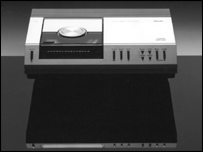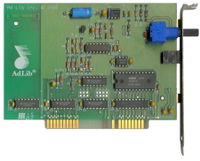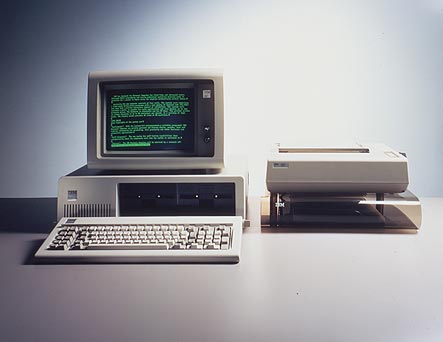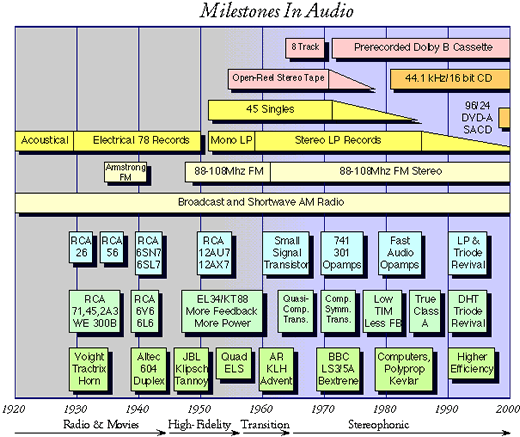Three generations
 In 1877 Edison demonstrated his phonograph. This was the beginning of reproducing music.
In 1877 Edison demonstrated his phonograph. This was the beginning of reproducing music.
If one look at the history of recording music there are 3 generations.
The icon of the first generation is of course the gramophone. A wind-up motor and a needle coupled to a diaphragm and amplified by a horn. No electrical parts!
 In the eighties the CD hit the market. The music is stored in a digital format. One might also argue that it is a turntable with the needle replaced by a laser. You need a platter and what’s on it you can find on a leaflet, just like good old vinyl. So high tech used in the traditional way.
In the eighties the CD hit the market. The music is stored in a digital format. One might also argue that it is a turntable with the needle replaced by a laser. You need a platter and what’s on it you can find on a leaflet, just like good old vinyl. So high tech used in the traditional way.
 The third generation is computer audio.
The third generation is computer audio.
You download the music from the internet. You browse your collection on your computer and of course, play it on a computer. The whole process of buying, storage, selecting and playing is fully digital.
You need some sort of computer to listen to the music, MP3 player, Pc, Mac, streaming audio player are some examples.
| 1841 | Augustin-Louis Cauchy is the first to propose sampling theory. | ||||||||
| 1855 | Leon Scott de Martinville invents the phonoautograph, a machine that records vibrations on a carbonized paper cylinder. | ||||||||
| 1876 | Alexander Graham Bell introduces the telephone. | ||||||||
| 1877 | Thomas Edison invents the phonograph while trying to invent a device that would record and repeat telegraphic signals (digital). | ||||||||
| 1887 | Emily Berliner replaces Edison's wax cylinder phonograph with the audio disc. | ||||||||
| 1915 | 78 R.P.M records introduced. | ||||||||
| 1928 | Harry Nyquist presents sampling theory to the American Institute of Electrical Engineers. 33 1/3 Records Introduced. |
||||||||
| 1937 | A. Reeves invents pulse code modulation (PCM), a technology used by computers and CDs for audio at present. H. Aiken from Harvard approaches IBM and proposes a electrical computing machine. |
||||||||
| 1943 | The U.S. Army turns on the first computer (ENIAC) at the University of Pennsylvania. | ||||||||
| 1947 | Magnetic Tape Recorders hit the U.S. market. | ||||||||
| 1948 | John Bardeen, William Shockley and Walter Brattain’s bipolar junction transistor, which made compact digital circuitry a reality. | ||||||||
| 1949 | 45 rpm records hit the U.S. market, thanks to microgroove technology. | ||||||||
| 1958 | C.H. Townes and A.L. Shawlow invent the laser. Jack Kilby and Robert Noyce co-invent the integrated circuit. Integrated circuits are used in almost all electronic equipment in use today and have revolutionized the world of electronics. Stereo LPs produced |
||||||||
| 1960 | I.S. Reed and G. Solomon publish information on multiple error correction codes. These come to be known as the "Reed-Solomon" Codes. Reed–Solomon codes are used in a wide variety of applications, like CDs, DVDs and Blu-ray Discs, in data transmission technologies such as DSL & WiMAX, in broadcast systems such as DVB and ATSC, |
1967 | Japan’s NHK Technical Research Institute publicly demonstrates a digital audio recorder running 12bit resolution and a 30kHz sampling rate. | 1969 | Physicist Klaas Compaan uses a glass disc to store black and white holographic images using frequency modulation at Philips Laboratories.
The global Internet's progenitor was the Advanced Research Projects Agency Network (ARPANET) of the U.S. Department of Defense. ARPANET become operational in 1969, connecting 4 computers. If you download some copyright protected material, don't forget to say thanks to the Pentagon. |
1971 | Microprocessor produced by Intel Digital. Delay line used by BBC's studios (first digital audio device). |
||
| 1973 | BBC and other broadcast companies start installing digital recorders for master recordings. | ||||||||
| 1977 | Sony, Mitsubishi and Hitachi demonstrate digital audio discs. | 1980 | Sony signs up to Philips ‘Red Book’ laser disc; Compact Disc is born. | ||||||
| 1981 | The IBM PC's debut.
|
||||||||
| 1983 | Compact Disc Technology is introduced in the United States.
|
||||||||
| 1987 | Sony launches Digital Audio Tape (DAT) with 16bit, 48kHz digital PCM system. The Fraunhofer Institut in Germany begins research code-named EUREKA project EU147, Digital Audio Broadcasting (DAB). |
1988 | First sound cards for PCs | 1989 | Fraunhofer received a German patent for MP3. | ||||
| 1991 | Multimedia Programming Interface and Data Specifications 1.0 by Microsoft and IBM. Resource Interchange File Format (RIFF), a tagged file structure including WAV |
||||||||
| 1992 | Fraunhofer's coding algorithm was integrated into MPEG-1. | ||||||||
| 1994 | MP3 (MPEG 1 Audio Layer 3) finalized. A compressed, lossy 16/44.1 format using approximately 20% of the space of a WAV file, it ushers in online music distribution. | 1995 | RealAudio, an audio streaming technology, lets the Net hear in near real-time. Radio HK, the first commercial 24 hr., Internet-only radio station starts broadcasting |
||||||
| 1999 | Super Audio Compact Disc (SACD) launched, offering high resolution digital sound using the Direct Stream Digital (DSD) system DVD-A introduced. |
2000 | Internet music-swapping site "Napster". Slim Devices founded. One of the pioneers of streaming audio. |
||||||
| 2001 | iPod launched. | ||||||||
| 2008 | Spotify - streaming audio service. Spotify Free (160kbit/s) and Spotify Premium $11.99/month (up to 320kbit/s) | ||||||||
| 2009 | Ayre QB9
The first “audiophile” USB DAC with asynchronous USB. |
||||||||
| 2014 | Tidal - lossless streaming service (FLAC) $19.99 month |
From Cave Paintings to the Internet
History of the CD - timeline 1841-1999
The Dawn of Commercial Digital Recording - Thomas Fine



